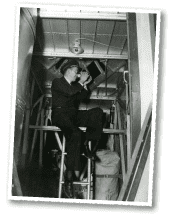
Early Navigation Equipment Used on Nonstop Transatlantic Flights
Today, communicating and navigating for planes is all done by computers, satellites, and GPS. But during the flying boat era in the 1930s and 1940s, it was a very different story. They literally navigated by the sun, moon, and stars.
There are difficulties navigating over featureless expanses of water for thousands of miles, and the weather, especially in the North Atlantic Ocean, is often unpredictable and violent. Pilots and navigators used a number of types of equipment to direct their flying boats across the vast sea.
Drift Flares
When you’re flying in an enclosed airplane, it’s hard to determine the strength and direction of the wind. In the days of flying boats, no equipment was available to provide this information, so the navigator would periodically toss smoke bombs from the plane that would burn on the surface of the sea, letting him measure the drift. In those days, planes flew much lower than modern aircraft.
Sextants
 Sextants were used by flying boats as well as ships. The navigator used it to take measurements from the sun during the day and from the moon and stars at night—provided the sky was clear! From these measurements, the navigator used a map and a series of mathematical formulas to calculate their position on a map.
Sextants were used by flying boats as well as ships. The navigator used it to take measurements from the sun during the day and from the moon and stars at night—provided the sky was clear! From these measurements, the navigator used a map and a series of mathematical formulas to calculate their position on a map.
Dead Reckoning
Essentially, dead reckoning was guessing your location based upon your last know location, your direction based on compass readings, your estimated speed, and the time that had elapsed since your last know location. Not an ideal form of navigation, but used as a guide nonetheless.
Morse Code
 Radio communication was available, but it wasn’t verbal; it was though the use of Morse code. Morse code is a series of long and short tones. Each letter and number has its own specific code. For example, A is a short tone followed by a long tone (•–), B is a long tone followed by three short tones (–•••), S is three short tones (•••), and O is three long tones (– – –). Information transmitted from the plane was generally updates on fuel and location, while the base typically transmitted weather information.
Radio communication was available, but it wasn’t verbal; it was though the use of Morse code. Morse code is a series of long and short tones. Each letter and number has its own specific code. For example, A is a short tone followed by a long tone (•–), B is a long tone followed by three short tones (–•••), S is three short tones (•••), and O is three long tones (– – –). Information transmitted from the plane was generally updates on fuel and location, while the base typically transmitted weather information.
After all this work, if the weather was too bad, or the head winds too strong resulting in greater fuel consumption, planes often had to turn back halfway through their 24 hour journey!










